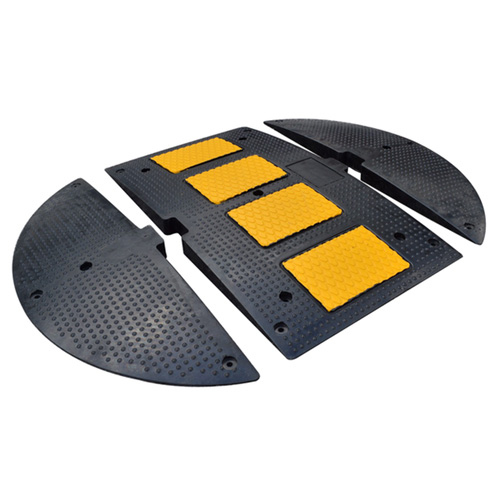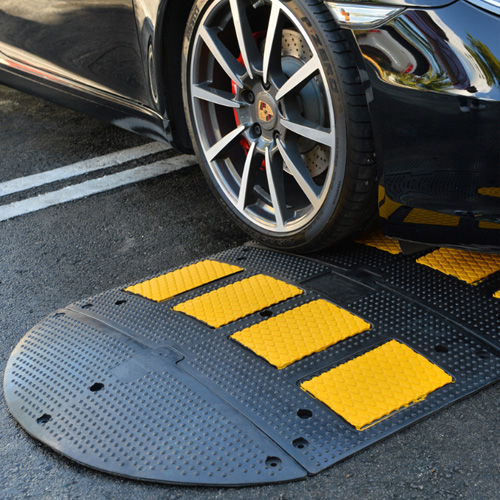The most common cause of traffic accidents and fatalities is regarded to be excessive speed. As cars accelerate, motorists are less able to maintain control over them in the event of poor road conditions, increasing the likelihood of a crash (often fatal). Roundabouts, traffic signs, and speed restrictions are just a few of the traffic calming techniques that authorities use to combat this issue. Speed humps, on the other hand, continue to be the most often utilized and most effective speed-limiting devices.

6’ Economy Recycled Rubber Heavy Duty Speed Bump
| SKU | Description | Length | Height | Width | Weight |
|---|---|---|---|---|---|
| SB206FT | 6 Ft Speed Bump (1) 6′ Section With no End Caps | 72″ | 2″ | 12″ | 48.40 |
| SB207FT | 7 Ft Speed Bump (1) 6′ Section + (2) End Caps | 86″ | 2″ | 12″ | 55.40 |
| SB213FT | Single Lane 12 Ft Speed Bump (2) 6′ Section With no End Caps | 144″ | 2″ | 12″ | 96.80 |
| SB219FT | Double lane 19 Ft Speed Bump (3) 6′ Section + (2) End Caps | 230″ | 2″ | 12″ | 152.20 |
| SB225FT | 25 Ft Speed Bump (4) 6′ Section + (2) End Caps | 302″ | 2″ | 12″ | 200.60 |
| SB2ECAP | End cap | 7′ | 2′ | 12′ | 3.50 |
Premium Recycled Rubber Safety-Striped Speed Hump – Reflective Rubber
| SKU | Description | Length | Height | Width | Weight |
|---|---|---|---|---|---|
| SB3039I | 39″ Speed Bump (1) 39″ Section With no End Caps | 39″ | 2″ | 13.7″ | 36.20 |
| SB3117I | 117″ Single Lane Speed Bump (3) 39″ Sections With no End Caps | 117″ | 2″ | 13.7″ | 108.60 |
| SB3137I | 137″ Single Lane Speed Bump (3) 39″ Sections + (2) End Caps | 137″ | 2″ | 13.7″ | 124.20 |
| SB3234I | 234″ Double lane Speed Bump (6) 39″ Sections With no End Caps | 234″ | 2″ | 13.7″ | 217.20 |
| SB3254I-2 | 254″ Double Lane Speed Bump (6) 39″ Sections + (2) End Caps | 254″ | 2″ | 13.7″ | 232.80 |
| SB3ECAP-2 | End cap | 10″ | 2″ | 13.7″ | 7.80 |
Recycled Rubber Speed Hump – Yellow / Black Single Lane or Double Lane
| SKU | Description | Length | Height | Width | Weight |
|---|---|---|---|---|---|
| SH1018I | 18.75″ Speed Bump (1) 18.75″ Section with no End Caps | 18.75″ | 1.25″ | 2″ | 22.20 |
| SH1112I | 112.5″ Single Lane Speed Bump (6) 18.75″ Sections with no End Caps | 112.5″ | 1.25″ | 2″ | 133.20 |
| SH1128I | 10 Ft Single Lane Speed Bump (6) 18.75″ Sections + (2) End Caps | 128.5 | 1.25″ | 2″ | 148.80 |
| SH1225I | 225″ Double Lane Speed Bump (12) 18.75″ Sections with no End Caps | 225″ | 1.25″ | 2″ | 266.40 |
| SH1241I | 20 Ft Double Lane Speed Bump (12) 18.75″ Sections + (2) End Caps | 241″ | 1.25″ | 2″ | 282.00 |
| SH1ECAL | LEFT End Cap | 8″ | 1.25″ | 2′ | 7.80 |
| SH1ECAR | RIGHT End Cap | 8″ | 1.25″ | 2′ | 7.80 |
Heavy Duty Rubber Speed Hump – Yellow / Black – Low Profile Speed Bump
| SKU | Description | Length | Height | Width | Weight |
|---|---|---|---|---|---|
| SH2019I | 19.75″ Speed Bump (1) 19.75″ Section With no End Caps | 19.75″ | 2″ | 3″ | 48.00 |
| SH2121I | 10 Ft Single Lane Speed Bump (5) 19.75″ Sections + (2) End Caps | 121.75″ | 2″ | 3″ | 273.00 |
| SH2240I | 20 Ft Double Lane Speed Bump (11) 19.75″ + (2) End Caps | 240″ | 2″ | 3″ | 561.00 |
| SH2ECAL | LEFT End cap | 11.5″ | 2″ | 3′ | 16.00 |
| SH2ECAR | RIGHT End cap | 11.5″ | 2″ | 3′ | 16.00 |
What are speed humps?
Speed humps are a kind of speed bump that was initially developed in the early 1900s and are a modification of that design. Despite the fact that the phrases speed humps and speed bumps are sometimes used interchangeably, they are not interchangeable. Both speed bumps and speed humps have a 2-4 inch gain in elevation. Nevertheless, since speed humps have a longer travel distance, the motorist experiences a more intense jolting sensation. A driver’s speed should be reduced to 15-20 miles per hour in order to decrease the jarring.
Normal installation locations for these speed-limiting road devices include local roads and lanes, accident-prone road sections, and regions where driving at a slower pace is favored but complete stops are not practical or essential. The materials they utilize for permanent installations include concrete and asphalt, while plastic and vulcanized rubber are used for temporary installations.
The successful usage and placement of this road safety equipment requires meticulous preparation on the part of the driver. The majority of the time, temporary bolt-down humps are installed for testing purposes prior to the implementation of a bigger project. Temporary speed bumps should be erected in such a manner that they do not interfere with on-street parking or bicycle lanes.
Benefits of speed humps
The use of speed humps may reduce vehicle speeds by up to 10-15 miles per hour when they are implemented appropriately. Vehicle speeds in places where they are placed were found to be significantly reduced (by up to 40%) according to a research done by the Iowa State University. It is quite good in preventing excessive speeding.
The installation of this speed restricting device has been linked to fewer accidents in road sections where it has been tested. Children are substantially less likely to be hit by automobiles on local roads and in communities where speed humps have been installed.
The effects of speed humps do not return with time, in contrast to the outcomes of other traffic calming measures. Road signs and speed restrictions are effective initially, but their effectiveness diminishes with time. When drivers are familiar with the existence of speed humps, they are more likely to slow down when approaching one of them.

Disadvantages of speed humps
However, although there is little doubt about the effectiveness of speed humps in making neighborhoods safer, some opponents have pointed up a number of drawbacks such as vehicle damage and wear and tear over time, delayed emergency response times, and increased traffic noise.
Professional paving contractors say that good planning and the use of right materials may help reduce these problems. Speed humps should be located on level roads, in close proximity to curbs, junctions, lighting, driveways, and manholes, among other features. Using plastic and rubber materials instead of asphalt and concrete may also help to lessen the amount of damage that cars sustain. Speed humps should also be made more apparent so that drivers are aware of their impending arrival. Additionally, signs should be put in addition to paint and reflective strips, particularly because speed humps may get engulfed in snow.
One of the most frustrating aspects of speed bumps is that they may lengthen the time it takes for emergency responders to get on the scene. They should be positioned in a staggered arrangement between opposing lanes and in a speed cushion layout to help alleviate this difficulty. This gives emergency vehicles the ability to manoeuvre around them.
Traffic speed humps raise noise levels by encouraging vehicles to rev up as they pass over them and by creating a steady onslaught of scraping autos. The usage of rubberized materials may aid in the reduction of noise. In order to minimise excessive noise, these devices should be located as far away from residential areas as is reasonably practical.
Finally, the cost of building and maintaining speed humps might be too high. The cost of a span of speed humps might range from $7,500 to $10,000. Removal, whether as a result of a court decision or as a result of public pressure, implies a significant financial outlay.
Final Thoughts:
Speed humps, like every other road safety device, have their own set of drawbacks and difficulties to contend with. Having them on our roads, however, is a justifiable compromise when you consider the countless advantages they provide, particularly in terms of keeping our roadways safer.

